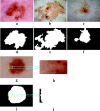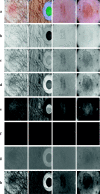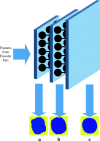Skin Lesion Segmentation with Improved Convolutional Neural Network
- PMID: 32378058
- PMCID: PMC7649844
- DOI: 10.1007/s10278-020-00343-z
Skin Lesion Segmentation with Improved Convolutional Neural Network
Abstract
Recently, the incidence of skin cancer has increased considerably and is seriously threatening human health. Automatic detection of this disease, where early detection is critical to human life, is quite challenging. Factors such as undesirable residues (hair, ruler markers), indistinct boundaries, variable contrast, shape differences, and color differences in the skin lesion images make automatic analysis quite difficult. To overcome these challenges, a highly effective segmentation method based on a fully convolutional network (FCN) is presented in this paper. The proposed improved FCN (iFCN) architecture is used for the segmentation of full-resolution skin lesion images without any pre- or post-processing. It is to support the residual structure of the FCN architecture with spatial information. This situation, which creates a more advanced residual system, enables more precise detection of details on the edges of the lesion, and an analysis independent of skin color can be performed. It offers two contributions: determining the center of the lesion and clarifying the edge details despite the undesirable effects. Two publicly available datasets, the IEEE International Symposium on Biomedical Imaging (ISBI) 2017 Challenge and PH2 datasets, are used to evaluate the performance of the iFCN method. The mean Jaccard index is 78.34%, the mean Dice score is 88.64%, and the mean accuracy value is 95.30% for the proposed method for the ISBI 2017 test dataset. Furthermore, the mean Jaccard index is 87.1%, the mean Dice score is 93.02%, and the mean accuracy value is 96.92% for the proposed method for the PH2 test dataset.
Keywords: CNN; FCN; Melanoma; Segmentation; Skin lesion segmentation.
Conflict of interest statement
The authors declare that they have no conflict of interest.
Figures








Similar articles
-
Skin lesion segmentation in dermoscopy images via deep full resolution convolutional networks.Comput Methods Programs Biomed. 2018 Aug;162:221-231. doi: 10.1016/j.cmpb.2018.05.027. Epub 2018 May 19. Comput Methods Programs Biomed. 2018. PMID: 29903489
-
Efficient skin lesion segmentation using separable-Unet with stochastic weight averaging.Comput Methods Programs Biomed. 2019 Sep;178:289-301. doi: 10.1016/j.cmpb.2019.07.005. Epub 2019 Jul 8. Comput Methods Programs Biomed. 2019. PMID: 31416556
-
Skin lesion segmentation using high-resolution convolutional neural network.Comput Methods Programs Biomed. 2020 Apr;186:105241. doi: 10.1016/j.cmpb.2019.105241. Epub 2019 Dec 4. Comput Methods Programs Biomed. 2020. PMID: 31837637
-
Automatic skin lesion segmentation based on FC-DPN.Comput Biol Med. 2020 Aug;123:103762. doi: 10.1016/j.compbiomed.2020.103762. Epub 2020 Jul 17. Comput Biol Med. 2020. PMID: 32768035
-
Deep Learning Approaches Towards Skin Lesion Segmentation and Classification from Dermoscopic Images - A Review.Curr Med Imaging. 2020;16(5):513-533. doi: 10.2174/1573405615666190129120449. Curr Med Imaging. 2020. PMID: 32484086 Review.
Cited by
-
Skin Cancer Detection and Classification Using Neural Network Algorithms: A Systematic Review.Diagnostics (Basel). 2024 Feb 19;14(4):454. doi: 10.3390/diagnostics14040454. Diagnostics (Basel). 2024. PMID: 38396492 Free PMC article. Review.
-
Robust fusion for skin lesion segmentation of dermoscopic images.Front Bioeng Biotechnol. 2023 Mar 20;11:1057866. doi: 10.3389/fbioe.2023.1057866. eCollection 2023. Front Bioeng Biotechnol. 2023. PMID: 37020509 Free PMC article.
-
Dermo-Seg: ResNet-UNet Architecture and Hybrid Loss Function for Detection of Differential Patterns to Diagnose Pigmented Skin Lesions.Diagnostics (Basel). 2023 Sep 12;13(18):2924. doi: 10.3390/diagnostics13182924. Diagnostics (Basel). 2023. PMID: 37761291 Free PMC article.
-
Machine Learning and Deep Learning Methods for Skin Lesion Classification and Diagnosis: A Systematic Review.Diagnostics (Basel). 2021 Jul 31;11(8):1390. doi: 10.3390/diagnostics11081390. Diagnostics (Basel). 2021. PMID: 34441324 Free PMC article. Review.
-
Integrating Domain Knowledge into Deep Learning for Skin Lesion Risk Prioritization to Assist Teledermatology Referral.Diagnostics (Basel). 2021 Dec 24;12(1):36. doi: 10.3390/diagnostics12010036. Diagnostics (Basel). 2021. PMID: 35054203 Free PMC article.
References
MeSH terms
LinkOut - more resources
Full Text Sources
Other Literature Sources
Medical

